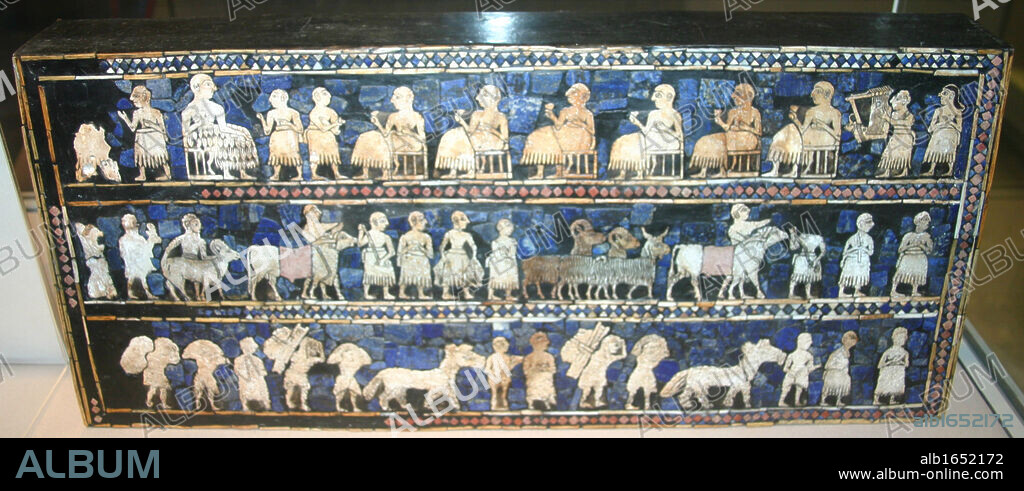alb1652172
The Standard of Ur, Sumerian artefact excavated from what had been the Royal Cemetery in the ancient city of Ur, dates from around 2600 - 2400 BC. Excavated by British archaeologist Sir Leonard Woolley in the 1920s. A hollow wooden box measuring 21.59 x 49.53 cm, inlaid with a mosaic of shell, red limestone and lapis lazuli. It is currently in a reconstructed state. The Standard of Ur has two main panels, 'War' and 'Peace'. Here in 'Peace' a banquet is represented. Attendants parade animals, fish, and other goods (possibly war booty) before seated figures, while a lyre player entertains the throng.

|
Add to another lightbox |
|
Add to another lightbox |



Caption:
The Standard of Ur, Sumerian artefact excavated from what had been the Royal Cemetery in the ancient city of Ur, dates from around 2600 - 2400 BC. Excavated by British archaeologist Sir Leonard Woolley in the 1920s. A hollow wooden box measuring 21.59 x 49.53 cm, inlaid with a mosaic of shell, red limestone and lapis lazuli. It is currently in a reconstructed state. The Standard of Ur has two main panels, 'War' and 'Peace'. Here in 'Peace' a banquet is represented. Attendants parade animals, fish, and other goods (possibly war booty) before seated figures, while a lyre player entertains the throng.
Credit:
Album / Universal Images Group / Universal History Archive
Releases:
Model: No - Property: No
Rights questions?
Rights questions?
Image size:
6436 x 2750 px | 50.6 MB
Print size:
54.5 x 23.3 cm | 21.5 x 9.2 in (300 dpi)
Keywords:
1910S • 1920S • 21 • 2400 • 2600 • 49 • 53 • 59 • AGRICOLA • AGRICOLTURE • AGRICULTURAL • AGRICULTURE • ANCIENT • ANIMAL • ANIMALS • ANT. OR.: UR, MESOPOTAMIA • ANTIQUE • ARABLE FARMING • ARCHAEOLOGIST • ARCHEOLOGIST • ARISTOCRACY • ARISTOCRAT • AROUND • ARTEFACT • ATTENDANTS • BANQUET • BC • BEFORE • BOX • BOXES • BRITISH • BURIAL GROUND • CEMETERY • CEMETERY: UR, MESOPOTAMIA (IRAQ) • CHEST • CITY • CIVILISATION • CLASS • CLOTHES • CLOTHING • CLOTHINGS • CM • COFFER • COSTUME • CROWD • CROWDED • CURRENTLY • DATES • DRESS • DRESSED • ENGLISH • ENTERTAINS • ENTOURAGE • EXCAVATED • FIGURES • FISH • FLEECE • GARMENT • GOODS • GRAVEYARD • HABIT • HÉRÉ • HOLLOW • HUNDRED YEARS WAR • INDUMENTARIA • INLAID • INSURRECTION • LAPIS • LAZULI • LÉONARD • LIMESTONE • LIRA • LOOT • LYRA • LYRE • MAIN • MEASURING • MESOPOTAMIA: UR • MOSAIC • MULTITUDE • MUSIC • MUSICAL INSTRUMENT LYRE • NOBILITY • NOBLE • NOBLEMAN • NOBLES • OLD • ORGY • PANELS • PARADE (PROCESSION) • PARADE • PEACE • PEASANT • PILLAGING • PLAYER • PLUNDERING • POSSIBLY • REBELLION • RECONSTRUCTED • RED (COLOUR) • RED • REPRESENTED • RETINUE • REVOLT • ROBE • ROYAL • ROYALS • RUSH (CROWD) • SEATED • SHELL • SIR • SIT • SITS • SITTING • STANDARD • STATE • SUIT • SUMERIAN • SYMPOSION • THRONG • TOWN • TOWNS • TWENTIES, THE • TWO • UR • UR, MESOPOTAMIA • WAR • WARFARE • WARS • WEIR • WHILE • WOODEN • WOOL • WOOLLEY
 Pinterest
Pinterest Twitter
Twitter Facebook
Facebook Copy link
Copy link Email
Email

